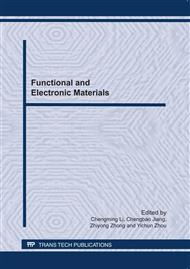p.12
p.15
p.21
p.26
p.34
p.39
p.44
p.51
p.55
Effect of Pr on the Microstructure and Electrical Properties of Ta-Doped TiO2 Capacitor-Varistor Ceramics
Abstract:
TiO2 varistors doped with 0.1 mol% Ta and different concentrations of Pr3+ were obtained by ceramic sintering processing at 1400 °C and their properties were characterized by XRD, SEM, I-V and impedance spectroscopy. The effect of Pr on the microstructure, nonlinear electrical behavior and dielectric properties of the Ta-doped TiO2 ceramics were investigated. It is found that Pr affects the grain size, electrical properties and the dielectric properties of the TiO2-based varistors. The samples have the nonlinear coefficients (α) values of (3.0-5.0) with low breakdown voltages (4-30 V/mm). A small quantities of Pr can improve the nonlinear properties of the samples significantly. It was found that an optimal doping composition of 0.5 mol% Pr3+ leads to a low breakdown voltage of 9.2 V/mm, a high nonlinear constant of 4.9 and an ultrahigh electrical permittivity of 8.38×104 (at 1 kHz), which is consistent with the highest grain boundary barriers of the ceramics. In view of these electrical characteristics, the TiO2-0.5 mol% Pr3+ ceramic is a viable candidate for capacitor-varistor functional devices. The defects theory was introduced to explain the nonlinear electrical behavior of Pr-doped TiO2 ceramics.
Info:
Periodical:
Pages:
34-38
Citation:
Online since:
June 2011
Authors:
Keywords:
Price:
Сopyright:
© 2011 Trans Tech Publications Ltd. All Rights Reserved
Share:
Citation:


